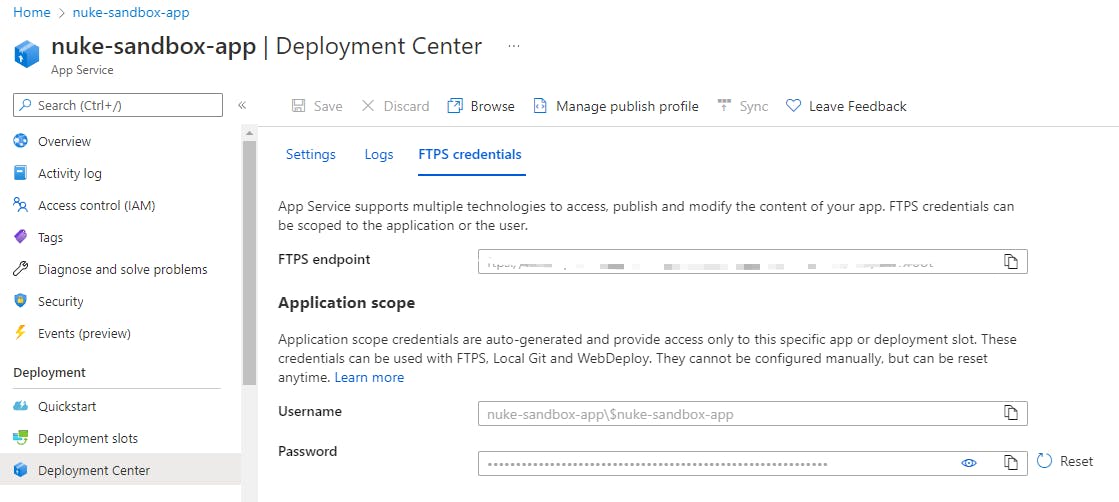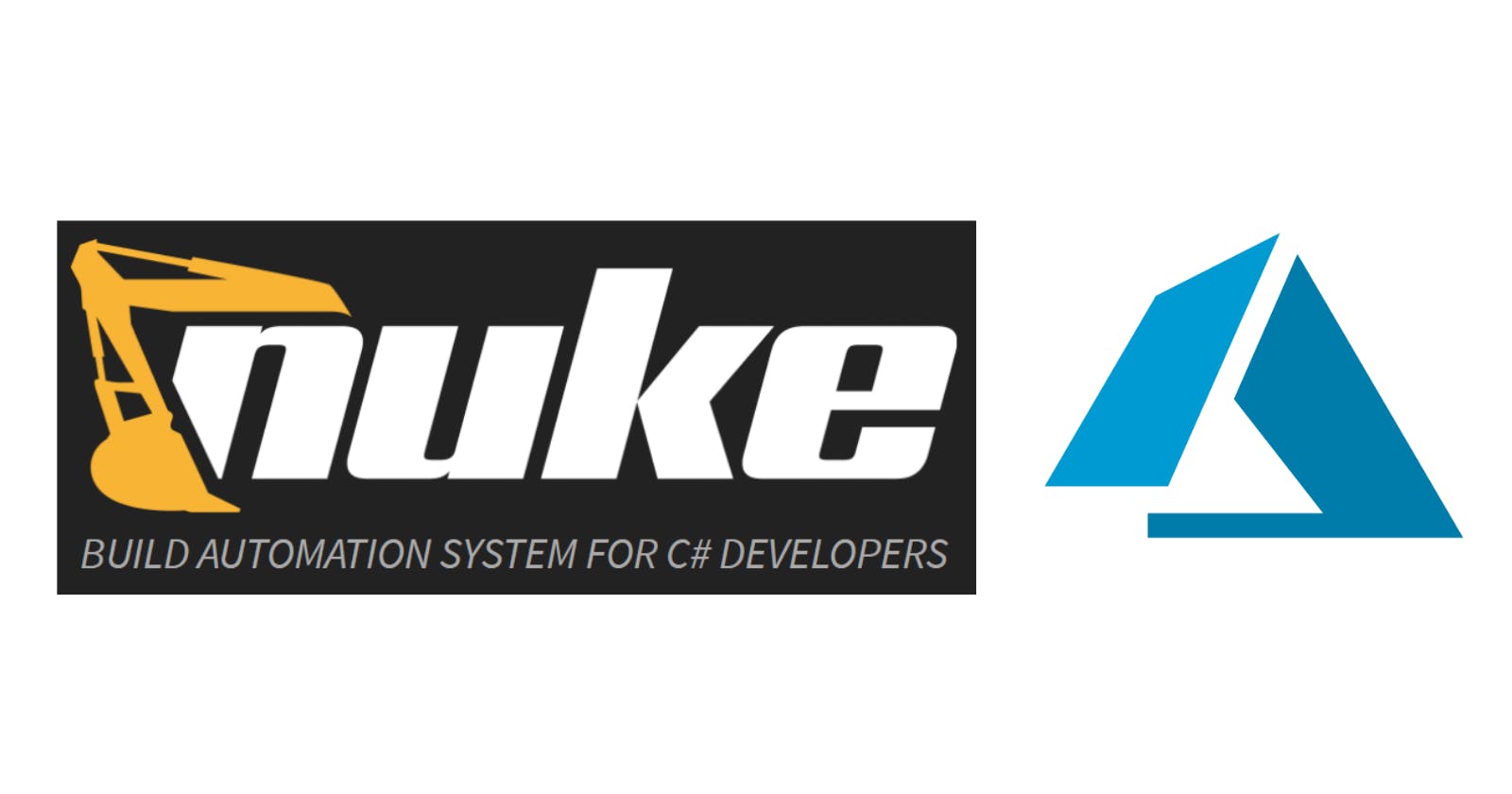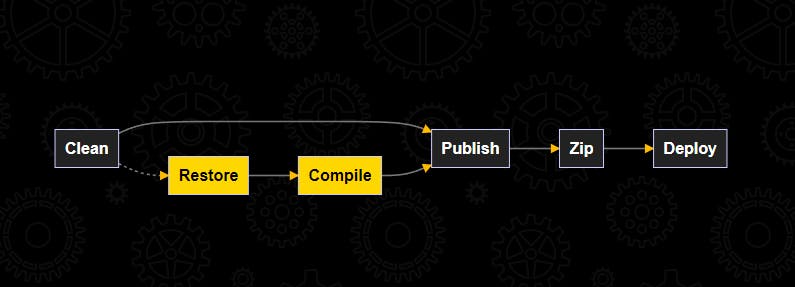In this post, we are going to explore the benefits of Nuke and its most common features (while we deploy a web app to Azure) to achieve a flexible, maintainable, automated build process.
Nuke is an open source, cross-platform build automation solution for .NET projects. Nuke prides itself on its simplicity and extensibility that makes build automation approachable for everyone.
Today some tools are doing the same job, Continuous Integration Servers. Then, why should we move the build process from the CI Servers to Nuke and let them as a dumb runner of it?:
Reduce Vendor Lock-In: If you change from one CI platform to another, there will be a huge effort to do it again.
Democratize DevOps: If something breaks or a developer adds a feature that requires changes in the build process, nothing can move forward until the build manager is free.
Reduce Mismatch: There are cases where a change affects both code and the build process. Then when you move the feature to the develop branch, you must remember to update the associated build process (and the same happens when you move it to another type of branch).
Simplify Debugging: When things go wrong on a CI server with custom logic, you can't set breakpoints, environmental differences are inaccessible, logging options are limited, and you frequently have to wait very long times to see the results of any changes.
Concepts
Target
A target is something that must happen. A collection of targets define your build process. They are analogous to your build steps in your CI server.
Target Restore => _ => _
.Executes(() =>
{
DotNetRestore(s => s
.SetProjectFile(Solution));
});
Parameters
A parameter is a value provided by the command line.
[Parameter("Configuration to build - Default is 'Debug' (local) or 'Release' (server)")]
readonly Configuration Configuration = IsLocalBuild ? Configuration.Debug : Configuration.Release;
Dependencies
A dependency defines what targets should run before.
Target Compile => _ => _
.DependsOn(Restore)
.Executes(() =>
{
DotNetBuild(s => s
.SetProjectFile(Solution)
.SetConfiguration(Configuration)
.EnableNoRestore());
});
Code
Let's begin installing Nuke:
dotnet tool install Nuke.GlobalTool --global
Then in the same path of your solution, run:
nuke :setup
Nuke will start to ask questions to configure your build project:
NUKE Global Tool version 6.0.1 (Windows,.NETCoreApp,Version=v3.1)
How should the build project be named?
¬ _build
Where should the build project be located?
¬ ./build
Which NUKE version should be used?
¬ 6.0.3 (latest release)
Which solution should be the default?
¬ nuke-sandbox-app.sln
Do you need help getting started with a basic build?
¬ No, I can do this myself...
At this point, Nuke is going to include a new project named _build in your solution. Locate the file Build.cs inside and open it. Add the following namespaces to get access to all dotnet commands:
using Nuke.Common.Tools.DotNet;
using static Nuke.Common.Tools.DotNet.DotNetTasks;
Delete all the targets and copy the following code:
Target Restore => _ => _
.Executes(() =>
{
DotNetRestore(s => s
.SetProjectFile(Solution));
});
Target Compile => _ => _
.DependsOn(Restore)
.Executes(() =>
{
DotNetBuild(s => s
.SetProjectFile(Solution)
.SetConfiguration(Configuration)
.EnableNoRestore());
});
Open a console in the same directory of your solution and run:
nuke Compile
╬════════════
║ Restore
╬═══
09:23:21 [INF] > "C:\Program Files\dotnet\dotnet.exe" restore D:\Source\Github\nuke-sandbox\nuke-sandbox-app.sln
09:23:21 [DBG] Determining projects to restore...
09:23:22 [DBG] Restored D:\Source\Github\nuke-sandbox\nuke-sandbox-app\nuke-sandbox-app.csproj (in 87 ms).
╬════════════
║ Compile
╬═══
09:23:22 [INF] > "C:\Program Files\dotnet\dotnet.exe" build D:\Source\Github\nuke-sandbox\nuke-sandbox-app.sln --configuration Debug --no-restore
09:23:22 [DBG] Microsoft (R) Build Engine version 17.1.0+ae57d105c for .NET
09:23:22 [DBG] Copyright (C) Microsoft Corporation. All rights reserved.
09:23:22 [DBG]
09:23:25 [DBG] nuke-sandbox-app -> D:\Source\Github\nuke-sandbox\nuke-sandbox-app\bin\Debug\net6.0\nuke-sandbox-app.dll
09:23:26 [DBG]
09:23:26 [DBG] Build succeeded.
09:23:26 [DBG] 0 Warning(s)
09:23:26 [DBG] 0 Error(s)
09:23:26 [DBG]
09:23:26 [DBG] Time Elapsed 00:00:03.33
═══════════════════════════════════════
Target Status Duration
───────────────────────────────────────
Restore Succeeded < 1sec
Compile Succeeded 0:03
───────────────────────────────────────
Total 0:04
═══════════════════════════════════════
Congratulations, you are compiling your solution with Nuke. Now, to deploy the web app to Azure, we are going to use the Kudu's zip API. We need to create a target to run the dotnet publish and another to zip the results. Add two AbsolutePath to store the results of the commands:
AbsolutePath OutputDirectory => RootDirectory / "output";
AbsolutePath ArtifactDirectory => RootDirectory / "artifact";
And add the following targets:
Target Clean => _ => _
.Before(Restore)
.Executes(() =>
{
EnsureCleanDirectory(OutputDirectory);
EnsureCleanDirectory(ArtifactDirectory);
});
Target Publish => _ => _
.DependsOn(Compile)
.DependsOn(Clean)
.Executes(() =>
{
DotNetPublish(s => s
.SetProject(Solution)
.SetConfiguration(Configuration)
.SetOutput(OutputDirectory)
.EnableNoRestore()
.SetNoBuild(true));
});
Target Zip => _ => _
.DependsOn(Publish)
.Executes(() =>
{
ZipFile.CreateFromDirectory(OutputDirectory, ArtifactDirectory / "deployment.zip");
});
Run the nuke command and check the output and artifact folders:
nuke Zip
Let's go to the final step, add three parameters:
[Parameter()]
public string WebAppUser;
[Parameter()]
public string WebAppPassword;
[Parameter]
public string WebAppName;
And copy this target:
Target Deploy => _ => _
.DependsOn(Zip)
.Requires(() => WebAppUser)
.Requires(() => WebAppPassword)
.Requires(() => WebAppName)
.Executes(async () =>
{
var base64Auth = Convert.ToBase64String(Encoding.Default.GetBytes($"{WebAppUser}:{WebAppPassword}"));
using (var memStream = new MemoryStream(File.ReadAllBytes(ArtifactDirectory / "deployment.zip")))
{
memStream.Position = 0;
var content = new StreamContent(memStream);
var httpClient = new HttpClient();
httpClient.DefaultRequestHeaders.Authorization = new System.Net.Http.Headers.AuthenticationHeaderValue("Basic", base64Auth);
var requestUrl = $"https://{WebAppName}.scm.azurewebsites.net/api/zipdeploy";
var response = await httpClient.PostAsync(requestUrl, content);
if (!response.IsSuccessStatusCode)
{
Assert.Fail("Deployment returned status code: " + response.StatusCode);
}
}
});
To get the user and password, go to the Azure portal and locate the Deployment Center option:

For the user, use the last part after the backslash. Run the help command to see all the available options to run your build:
nuke --help
NUKE Execution Engine version 6.0.3 (Windows,.NETCoreApp,Version=v6.0)
Targets (with their direct dependencies):
Restore
Compile (default) -> Restore
Clean
Publish -> Compile, Clean
Zip -> Publish
Deploy -> Zip
Parameters:
--configuration Configuration to build - Default is 'Debug' (local) or
'Release' (server).
--web-app-password <no description>
--web-app-user <no description>
--web-app-name <no description>
--continue Indicates to continue a previously failed build attempt.
--help Shows the help text for this build assembly.
--host Host for execution. Default is 'automatic'.
--no-logo Disables displaying the NUKE logo.
--plan Shows the execution plan (HTML).
--profile Defines the profiles to load.
--root Root directory during build execution.
--skip List of targets to be skipped. Empty list skips all
dependencies.
--target List of targets to be invoked. Default is 'Compile'.
--verbosity Logging verbosity during build execution. Default is
'Normal'.
Run the following command:
nuke Deploy --web-app-password <pasword> --web-app-name nuke-sandbox-app --web-app-user '$nuke-sandbox-app'
Go to your site to see the web app running. Finally, to see your build process in a nice dependency graph, run:
nuke --plan
You can find the solution here and the official Nuke documentation here.


